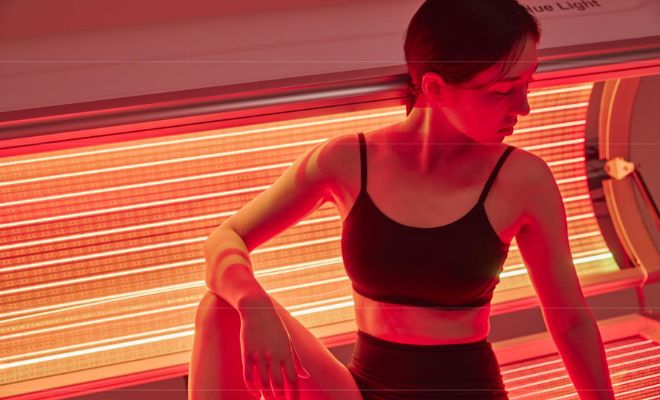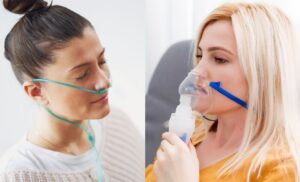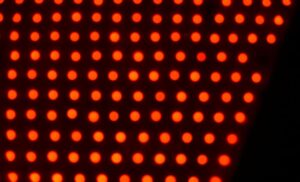You’ve probably seen it everywhere. Glowing panels in luxury spas, sleek devices in cutting-edge fitness centers, and even tucked into your favorite influencer’s wellness routine. Red light therapy is having a major moment, hailed for its potential to deliver everything from clearer, younger-looking skin to quicker muscle recovery.
But as you browse the endless options for LED masks and therapy panels, a critical question arises: Is all red light the same?
The short answer is no. The color you see is just the beginning. The real magic lies in the science of Photobiomodulation (PBM), and the key to its effectiveness is using the right wavelengths. Think of it this way: asking for the “best” red light is like asking a musician for the “best” musical note. The power isn’t in a single note, but in the harmony of a well-composed chord.
This guide will walk you through the optimal ranges and show you why a blend of wavelengths is superior to just one.
The Science in a Nutshell: What is Photobiomodulation?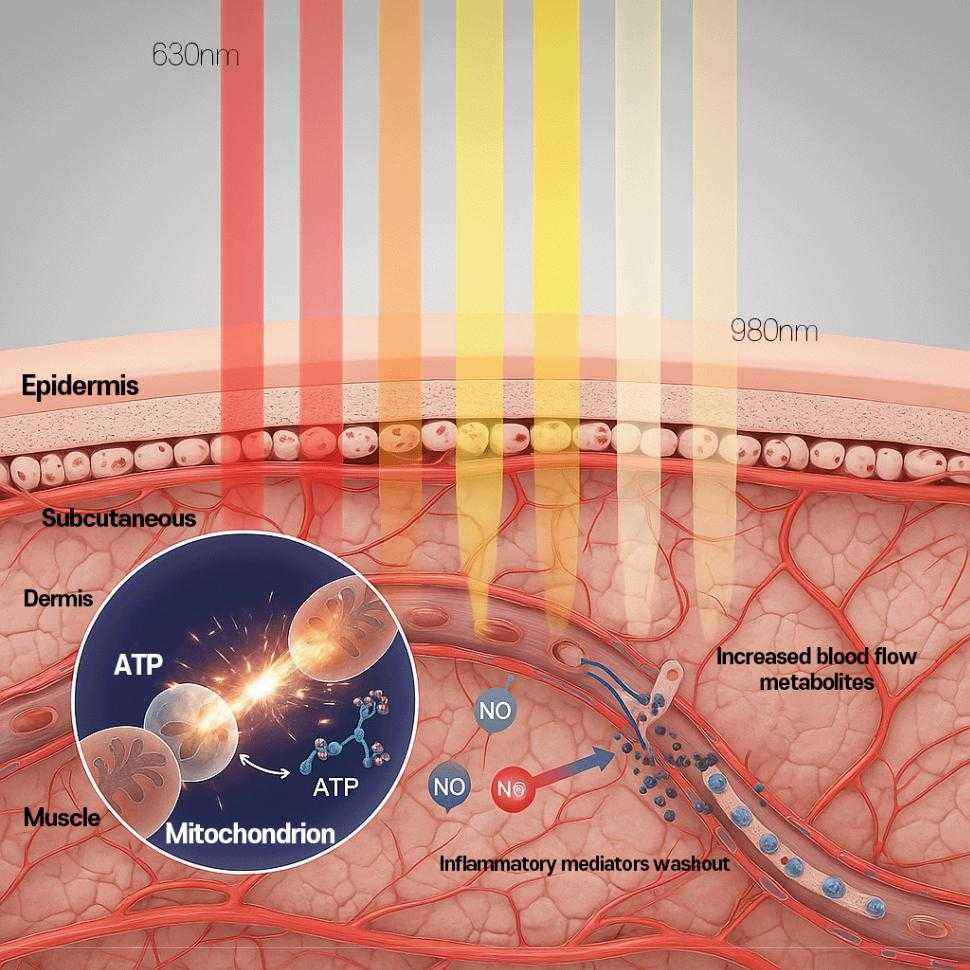
Before we dive into the numbers, let’s clarify what we’re talking about. “Red Light Therapy” is the popular term for a scientific process called Photobiomodulation (PBM). It’s not just illumination; it’s a biological interaction.
In PBM therapy, specific wavelengths of light penetrate the skin and are absorbed by the mitochondria (the “powerhouses”) within your cells. This absorption stimulates a key enzyme called Cytochrome C Oxidase.
According to groundbreaking research by scientists like Dr. Tiina Karu and NASA-backed studies led by Dr. Harry Whelan, this stimulation kicks off two incredible processes:
- Increased ATP Production: Mitochondria produce more ATP, the universal energy currency of your cells. More ATP means your cells have more energy to repair, regenerate, and function at their best.
- Nitric Oxide (NO) Release: The process releases stored nitric oxide, a vasodilator that improves blood circulation. This brings more oxygen and nutrients to tissues while helping to clear out waste and reduce inflammation.
The result? Faster wound healing, reduced inflammation, improved skin health, and enhanced muscle recovery. (source)
Related Article: Photobiomodulation vs Red Light Therapy: What’s the Difference?
Finding Your Frequency: A Chart of Optimal Wavelength Ranges

The depth and effect of PBM are entirely dependent on the wavelength of light used. Wavelengths are measured in nanometers (nm), and different nanometers target different layers of tissue.
Here is a chart breaking down the most scientifically backed therapeutic ranges:
| Wavelength Range | Light Type | Penetration & Primary Target | Best For |
| 630nm – 680nm | Red Light | Superficial: Skin surface, sebaceous glands, hair follicles. | Skin Health & Surface Healing: Stimulating collagen, reducing wrinkles, accelerating wound healing, managing acne and rosacea. |
| 780nm – 830nm | Near-Infrared (NIR) | Deeper: Muscles, nerves, connective tissue, bones, and joints. | Pain, Inflammation & Recovery: Soothing sore muscles, reducing joint pain, calming nerve irritation, and speeding up recovery. |
| 900nm – 980nm | Near-Infrared
(NIR) |
Deepest: Deep tissues, organs, and even the brain. | Deep Tissue & Systemic Health: Enhancing deep circulation, improving cellular metabolism, and supporting systemic functions. |
Understanding the Penetration Depth of Red Light Therapy
Red Light vs. Near-Infrared (NIR) Light Wavelengths
Red light therapy is widely used for promoting healing, reducing pain, and improving skin health. Its effectiveness depends largely on the wavelength and how deeply the light can penetrate the skin.
Red Light Wavelengths and Penetration Depth
Visible red light (620–700 nm) penetrates only about 1–2 mm into the skin, making it ideal for targeting surface-level concerns.
Applications of Red Light Therapy at These Wavelengths:
Wound healing: Stimulates cell growth and collagen production, accelerating wound closure.
Pain relief: Reduces inflammation and supports tissue repair, helping relieve pain in muscles, joints, and skin.
Skin health: Boosts collagen, improves elasticity, and reduces the appearance of wrinkles and fine lines.
For deeper tissue treatment, near-infrared (NIR) light with longer wavelengths (810–850 nm) penetrates deeper layers, making it suitable for muscle recovery and joint health.
Beyond Wavelength: Why Pulse and Blending Are Game-Changers
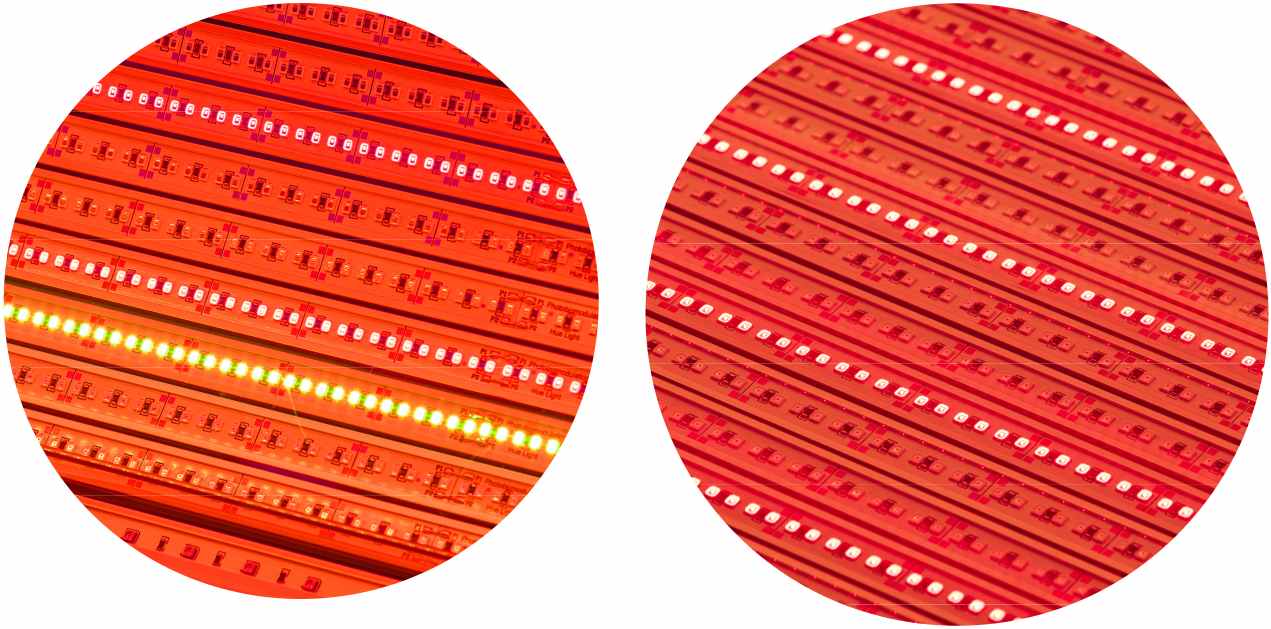
The most effective PBM therapy isn’t just about choosing one wavelength. Two other factors are critical: pulsing and blending.
-
The Power of Pulse
You might assume that a continuous beam of light (Continuous Wave) is best. However, research shows that cells can respond even better to light delivered in rhythmic pulses (Pulsed Wave).
- Continuous Wave (CW): Delivers a steady dose of energy.
- Pulsed Wave (PW): Stimulates cells with a rhythmic ON/OFF cycle. This method can be more effective at triggering biological responses like ATP production and nitric oxide release, and it reduces the amount of heat delivered to the tissue. Advanced systems even use specific frequencies, like Nogier frequencies, designed to resonate with the body’s own autonomic nervous system.
-
The Synergy of Blending
This brings us back to our music analogy. While one note is fine, a chord is far more powerful. The same is true for light. Low-cost devices often offer only a single wavelength. But advanced PBM technology, like that found in HueLight systems, blends multiple, distinct wavelengths (e.g., 660nm, 810nm, and 950nm) into a single, synergistic treatment.
This multi-wavelength approach allows you to:
- Target multiple tissue depths simultaneously.
- Address complex issues that involve the skin, muscle, and nerve.
- Achieve a more comprehensive and powerful biological effect.
Benefits of Red Light Therapy Wavelengths
Red light has been the most widely studied form of light therapy, first discovered in the 1960s and used extensively since. While other types of light therapy, such as blue and green light, are now gaining research attention, red light remains the focus of most studies.
Research has explored the health benefits of different red light wavelengths. Here are a few examples:
1. Stimulated hair growth (650 nm): An in vitro study found that 650 nm red light promoted hair growth.
2. Improved bone healing (660 nm and 880 nm): Studies showed that near-infrared light can immediately increase ATP production (cellular energy) and accelerate callus formation during fracture healing.
3. Reduced neuropathic pain (660 nm): A study suggested that 660 nm red light may support nerve regeneration and reduce neuropathic pain.
These examples represent just a fraction of the research on photobiomodulation and red light therapy, which continues to uncover new therapeutic possibilities.
Related Article: Best Time For Red Light Therapy
The Verdict: The Best “Wavelength” is a “Wavelength Strategy

So, what is the best wavelength for red light therapy?
The answer isn’t a single number. The best approach is a scientifically designed blend of wavelengths and pulses tailored to achieve a specific outcome. Instead of looking for one magic number, look for a device that offers a strategic combination of the most proven therapeutic ranges:
- Red Light ( ~660nm) for the skin.
- Near-Infrared ( ~810nm) for muscles and joints.
- Deeper Near-Infrared ( ~950nm) for deep tissue and systemic wellness.
By understanding that PBM is a science of harmony, a precise blend of wavelengths, pulses, and power, you can move beyond the hype and choose a red light therapy solution that delivers true, measurable results.
